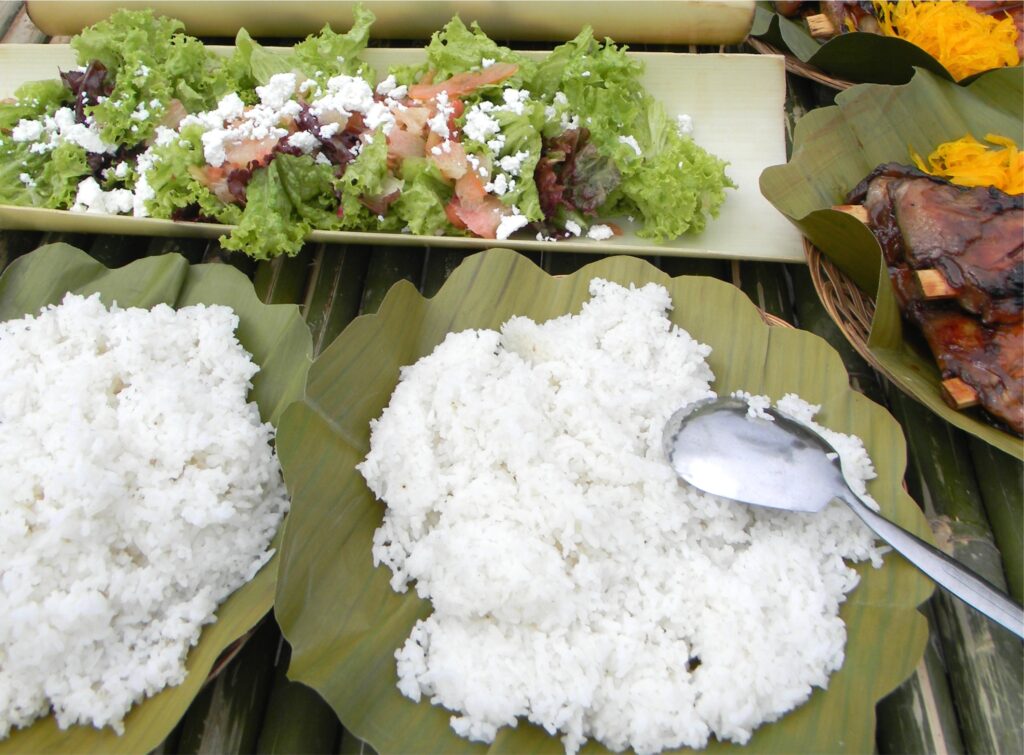Text and Photos by Henrylito D. Tacio
Move over, golden, black, brown, and red rice… there’s a new type of rice that will soon be a hit among Filipinos, particularly those with Type 2 diabetes.
In an effort to help curb the rising cases of diabetes globally, including in the Philippines, scientists from the Laguna-based International Rice Research Institute (IRRI) have identified the genes responsible for low and ultra-low glycemic index (GI) in rice.
“This new discovery will be able to convert popular rice varieties into low and ultra-low GI to refined white rice, through conventional breeding methods, keeping high-quality grain and without compromising yield,” the IRRI said in a press release.
The first batch of ultra-low GI rice samples, developed from the Samba Mahsuri x IR36ae, was already formally presented to Philippine President Ferdinand Marcos, Jr. at the opening ceremony of the 6th International Rice Congress in Manila.
“The discoveries in this congress will pave the way for greater strides in the rice industry in the Philippines and across the globe,” said Marcos in his speech.
IRRI has previously identified two low GI Philippine varieties, IRRI 147 and IRRI 125, that were already released in the Philippines as salt-tolerant varieties. Based on clinical validation on human volunteers in a cohort study, IRRI 147 depicted a GI value of 55 and IRRI 125 had a GI value of 51.1.

The Glycemic Index and Diabetes
GI is a measure of the rate at which carbohydrates as glucose enter the bloodstream. “The GI also indicates the rate at which carbohydrates break down during digestion in the small intestine into the simple sugars glucose, fructose and, sometimes, galactose,” explains Dr. Virgilio M. Ofiana in his weekly column for a national daily. “The glucose is the sugar that is rapidly absorbed and has a reference GI of 100 or greater,” Dr. Ofiana writes. “Both fructose and galactose enter the circulation at a slower rate and need to go to the liver for conversion into glucose: both, therefore, have lower GIs.”
Rice is primarily composed of carbohydrates, which make up almost 80% of its total dry weight. Most of the carbohydrates in rice is starch. Starch is the most common form of carbohydrates in foods.
This is the reason why doctors advise those with diabetes to eat less rice. The starch-rich staple can potentially release high amounts of sugar into the blood when digested.
A 2007 study of Chinese women in Shanghai found that middle-aged women who ate large amounts of rice and other refined carbohydrates were at increased risk for diabetes compared to their peers who ate less. In the United States, Americans who eat white rice on a regular basis — five or more times a week — are almost 20 percent more likely to develop diabetes than those who eat it less than once a month.
“Diabetes is a killer and you should not be complacent,” urges Dr. Willie T. Ong, an internist-cardiologist and author of How to Live Longer.
The Philippines is home to about four million diabetics, with more than three million not knowing they have the disease. “Many people still do not know that they have diabetes,” said Dr. Tommy Ty Wiling, president of Diabetes Philippines. The Department of Health listed diabetes as the ninth leading cause of death among Filipinos today.
The International Diabetes Federation reported there were 537 million people with diabetes in 2021 and this is expected to increase 47% by 2047.
Rice: Filipino staple food with high GI… until now?
Rice is the staple food of Filipinos. Many cultivated rice varieties have a GI ranging from 70 to 92, which is not considered healthy for people with diabetes.
IRRI classifies GI levels below 45 as ultra-low, 46-55 as low GI, 56-69 as intermediate GI, and high GI at 70 and above. The newly discovered ultra-low GI line has a GI level of 44, with translucent backgrounds.
Four years ago, in 2019, IRRI found highly significant marker-trait association markers for distinguishing intermediate versus high GI. The breakthrough comes in IRRI having now defined the genetics for low GI and ultra-low GI rice, and developed pre-breeding lines in a high-yielding background with low GI and ultra-low GI characteristic features.
“IRRI’s latest discovery offers the opportunity to develop rice varieties with low GI, and for the first time ever, ultra-low GI levels, to meet the health needs and dietary preferences of consumers,” said Dr. Nese Sreenivasulu, Head of IRRI’s Consumer-driven Grain Quality and Nutrition Research Unit and the lead of this discovery.

The IRRI researcher said that in collaboration with relevant institutions in different countries, these lines can also be used as donors to transfer low and ultra-low GI traits to popular rice varieties with different grain size and shape, as well as in different maturity backgrounds.
“We are keen on supporting the continued research for this milestone discovery. We are already discussing ways on how PhilRice can use this breakthrough on low GI rice toward incorporating this in Philippine varieties,” said R. Leo Sebastian, Undersecretary for Rice Industry Development of the Department of Agriculture.
“These research breakthroughs possess much-needed health benefits and tremendous market potential. We look to partnering with as many national systems as possible to help fast track the release of low and especially the ultra-low GI rice varieties,” said IRRI Interim Director General Dr. Ajay Kohli. He added the ultra-low GI variety will be market-ready within two years through a collaboration between IRRI and Philippine Rice Research Institute (PhilRice).
The development of a rice variety with low GI is a breakthrough waiting to happen. “This is good news for diabetics and people at risk of diabetes who are trying to control their condition through diet, as it means they can select the right rice to help maintain a healthy, low-GI diet,” Dr. Tony Bird, a researcher of Australia’s Commonwealth Scientific and Industrial Research Organization (CSIRO) Food Futures Flagship.
IRRI agrees. “Eating rice with other foods can help reduce the overall GI of a meal and, when combined with regular exercise, can reduce the chances of getting diabetes,” it said. “In addition, people who exercise need more carbohydrates in their diet and can take advantage of low-GI foods for sustained activity.” – ###








